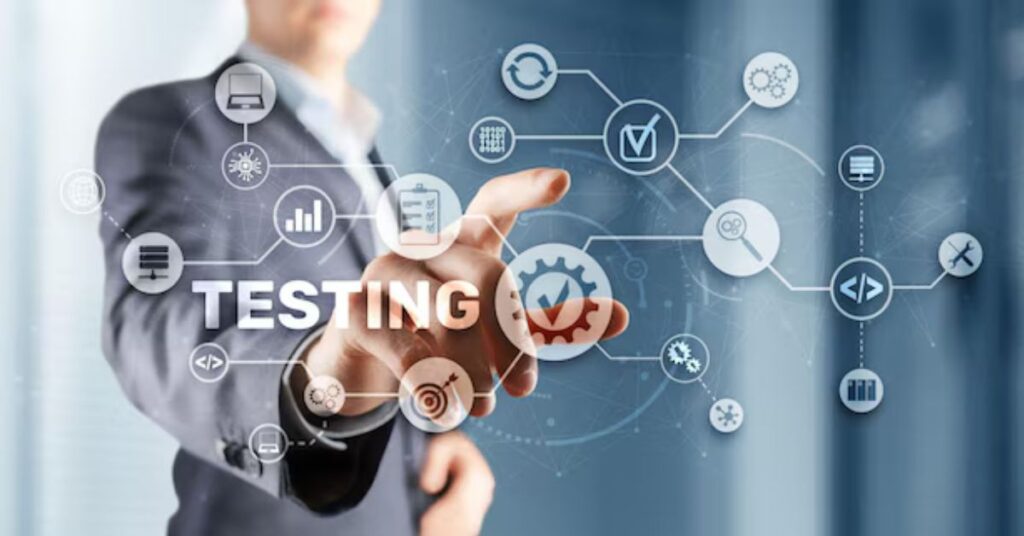Introduction:
The rapid advancements in testing technology are transforming industries across the globe. From healthcare and automotive to aerospace and electronics, the evolution of testing methods has led to increased efficiency, accuracy, and safety. With the rise of automation, artificial intelligence, and smart sensors, testing technology is becoming more sophisticated, allowing businesses to detect faults, ensure compliance, and optimize performance with unprecedented precision.
As industries continue to innovate, the demand for more reliable and faster testing solutions will only grow. Emerging technologies such as IoT-enabled testing, AI-powered diagnostics, and real-time monitoring are reshaping how businesses approach quality control and safety measures. The future of testing technology will not only enhance operational efficiency but also help industries meet evolving regulatory standards and sustainability goals.
The Role of Artificial Intelligence in Testing Technology:
Artificial intelligence (AI) is revolutionizing the way testing is conducted across various industries. Traditional testing methods often require manual analysis, which can be time-consuming and prone to errors. AI-powered testing solutions use machine learning algorithms to detect anomalies, predict failures, and enhance quality control in real-time.
Industries such as manufacturing, healthcare, and software development are already benefiting from AI-driven automation. In predictive maintenance, AI helps identify potential failures before they occur, reducing downtime and increasing productivity. As AI continues to evolve, testing technology will become even more efficient, offering businesses a proactive approach to quality assurance.
How AI is enhancing testing technology:
- Automated defect detection and pattern recognition.
- Predictive analytics for early fault detection and maintenance.
- Enhanced accuracy and efficiency in quality control processes.
- Machine learning algorithms improving testing precision over time.
The Impact of IoT and Smart Sensors on Real-Time Monitoring:
The Internet of Things (IoT) has brought a new level of connectivity to testing technology. IoT-enabled sensors can continuously monitor environmental conditions, structural integrity, and equipment performance, providing real-time data for immediate analysis.
This technology is particularly valuable in industries such as construction, energy, and transportation, where equipment failure can have serious consequences. Smart sensors can detect temperature fluctuations, pressure changes, and structural weaknesses, ensuring early intervention and reducing risks. As IoT technology advances, industries will see even greater efficiency in monitoring and maintaining their systems.
Benefits of IoT in testing technology:
- Real-time data collection for instant decision-making.
- Remote monitoring for improved safety and maintenance.
- Integration with AI for predictive maintenance and analytics.
- Increased accuracy in detecting operational inefficiencies.
How Automation Is Reducing Human Error in Testing:
Automation has significantly improved the accuracy and efficiency of testing processes across multiple industries. In the past, manual testing methods often introduced inconsistencies, leading to inaccurate results and potential safety risks. Today, automated testing equipment ensures repeatability, consistency, and speed.
In industries such as electronics manufacturing and pharmaceuticals, robotic testing systems can conduct thousands of tests per hour with minimal human intervention. These systems not only increase efficiency but also reduce operational costs and improve compliance with stringent regulatory standards.
Advantages of automation in testing technology:
- Eliminates human error, ensuring consistent and accurate results.
- Reduces testing time and increases productivity.
- Enhances compliance with industry regulations and quality standards.
- Improves safety by minimizing human exposure to hazardous environments.
The Future of Non-Destructive Testing in Quality Assurance:
Non-destructive testing (NDT) is an essential technique for evaluating the integrity of materials and structures without causing damage. As industries demand higher safety standards, NDT methods are evolving to provide more accurate and efficient results.
New advancements in ultrasonic, radiographic, and infrared testing are enabling industries such as aerospace and construction to detect defects without compromising the integrity of the tested material. The future of NDT will see the integration of AI and robotics, further improving precision and reducing testing time.
Why non-destructive testing is critical for industries:
- Ensures material integrity without damaging the tested object.
- Reduces downtime by allowing in-service inspections.
- Improves safety by detecting structural weaknesses early.
- Enhances accuracy with AI-driven data analysis.
The Growing Importance of Cybersecurity in Testing Equipment:
As testing technology becomes more connected through IoT and cloud-based solutions, cybersecurity is becoming a critical concern. Hackers can manipulate data, disrupt testing processes, or compromise sensitive results, leading to significant operational and financial risks.
Companies must implement strong cybersecurity measures to protect their testing infrastructure. Secure encryption, access control mechanisms, and regular security audits are essential in preventing cyber threats. As the digital landscape evolves, cybersecurity in testing technology will remain a top priority for businesses across all sectors.
Key cybersecurity strategies for testing technology:
- Encryption of sensitive testing data for secure storage.
- Multi-factor authentication for access control and user verification.
- Regular security audits to identify vulnerabilities.
- Implementation of blockchain technology for tamper-proof data logging.
The Role of Robotics in Advanced Testing Applications:
Robotics is playing a significant role in testing and inspection, particularly in industries where precision and safety are crucial. Automated robotic systems can conduct highly detailed inspections, navigate challenging environments, and perform repetitive tests with unmatched consistency.
For example, in the automotive industry, robotic arms equipped with sensors can perform crash tests, durability assessments, and material inspections at high speeds. In aerospace, robotic drones are used to inspect aircraft structures, identifying defects that might be missed by human inspectors. The integration of robotics in testing is set to enhance accuracy, efficiency, and safety across multiple industries.
Benefits of robotics in testing technology:
- Enhanced precision in quality control and defect detection.
- Ability to operate in hazardous environments where human access is limited.
- Increased testing speed and efficiency for mass production.
- Cost savings through automation of repetitive testing processes.
How Industry-Specific Testing Innovations Are Transforming Businesses:
Different industries require specialized testing equipment to meet their unique demands. Advances in industry-specific testing innovations are allowing businesses to improve product quality, enhance safety, and comply with regulations more efficiently.
For example, the medical industry is witnessing breakthroughs in diagnostic testing, where AI-driven imaging technology is improving early disease detection. Similarly, in the energy sector, advanced testing tools are optimizing renewable energy systems by ensuring solar panels and wind turbines function at peak efficiency. As industries continue to evolve, the demand for cutting-edge testing solutions will continue to grow.
Industry-specific innovations in testing technology:
- AI-assisted diagnostic testing in healthcare for early disease detection.
- Advanced material testing in aerospace for enhanced safety standards.
- Smart grid monitoring in the energy sector to improve efficiency.
- Automated quality control in food and beverage manufacturing.
Finding the Right Supplier for Advanced Testing Technology:
As testing technology continues to advance, finding a trusted supplier is essential to ensuring high-quality and reliable equipment. Businesses must work with suppliers that offer certified, industry-compliant products, as well as strong technical support and after-sales service.
Trusted suppliers like tester.co.uk provide a wide range of testing equipment for various industries, offering businesses the tools they need to maintain accuracy, efficiency, and compliance. Choosing a reputable supplier ensures that businesses have access to the latest innovations in testing technology, backed by expert guidance and support.
What to consider when selecting a testing equipment supplier:
- Range of certified and industry-compliant products.
- Technical support and training services.
- After-sales service, including calibration and maintenance.
- Reputation and customer reviews for reliability and trustworthiness.
Conclusion:
The future of testing technology is shaping industries by improving accuracy, efficiency, and safety. Advancements in AI, IoT, robotics, and automation are enabling businesses to optimize quality control, reduce risks, and enhance operational performance. As industries evolve, the demand for more intelligent and efficient testing solutions will continue to rise.
To stay competitive, businesses must embrace these innovations and work with trusted suppliers to ensure they have the latest testing technology. As the world moves toward smarter, faster, and more secure testing solutions, industries that invest in these advancements will set new benchmarks for quality, compliance, and efficiency in the years to come.







